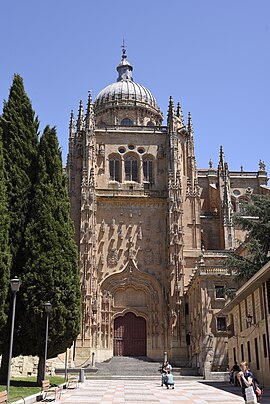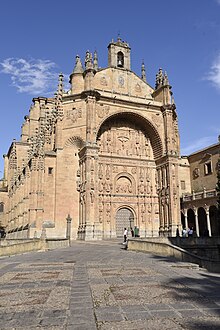Plateresque


Plateresque, meaning "in the manner of a silversmith" (plata being silver in Spanish), was an artistic movement, especially architectural, developed in Spain and its territories, which appeared between the late Gothic and early Renaissance in the late 15th century, and spread over the next two centuries. It is a modification of Gothic spatial concepts and an eclectic blend of Mudéjar, Flamboyant Gothic and Lombard decorative components, as well as Renaissance elements of Tuscan origin.[1]
Examples of this
Plateresque has been considered down to current times a Renaissance style by many scholars. To others, it is its own style, and sometimes receives the designation of Protorenaissance.[3][4] Some even call it First Renaissance in a refusal to consider it as a style in itself, but to distinguish it from non-Spanish Renaissance works.[5]
The style is characterized by ornate decorative facades covered with floral designs, chandeliers, festoons, fantastic creatures and all sorts of configurations.[2] The spatial arrangement, however, is more clearly Gothic-inspired. This fixation on specific parts and their spacing, without structural changes of the Gothic pattern, causes it to be often classified as simply a variation of Renaissance style.[6] In New Spain the Plateresque acquired its own configuration, clinging tightly to its Mudéjar heritage and blending with Native American influences.[2]
In Spain its development is most remarkable in the city of Salamanca although examples are found in most regions of the country.
In the 19th century with the rise of historicism, the Plateresque architectural style was revived under the name of Monterrey Style.[7]
Etymology
The term Plateresque came from the silversmith trade.
Problems of geographical area and consideration as Style

Traditionally Plateresque has been considered a style exclusively "Spanish", a term also applied to architecture in the Spanish territories held by the
This problem highlights the imprecision of the name Plateresque and the difficulties inherent in using it to describe productions from a period of confusion and transition between styles, especially since they are characterized by decorative profusion suggesting an attempt to disguise the failure of Spanish architects to develop new structural and spatial ideas. It has even been suggested that this problem could be solved by identifying what is called Plateresque as the replacement of Gothic decoration with grotesques inspired by the works of the Italian Sebastiano Serlio.[9]
Any persuasive argument, however, must admit that the Plateresque or Protorenaissance was an artistic movement that responded to the demands of the ruling classes of imperial Spain, which had just completed the Reconquista and begun the colonization of the Americas. The Spanish were developing a consciousness of their growing power and wealth, and in their exuberance launched a period of construction of grand monuments to symbolize these with what are now considered national treasures.
Features
Spanish Plateresque
Typical Plateresque facades, like those of altarpieces, were made as carefully as if they were the works of goldsmiths, and decorated as profusely. The decoration, although of various inspirations, was mainly of plant motifs, but also had a profusion of medallions, heraldic devices and animal figures, among others. Plateresque utilized a wealth of materials: gold plates on crests and roofs, vases, etc. There is evidence of more polychrome works at the conclusion of the first third of the 16th century, when there appeared heraldic crests of historical provenance and long balustrades, to mention one kind of less busy decoration.[10]
The proliferation of decoration for all architectural surfaces led to the creation of new surfaces and subspaces, which were in turn decorated profusely, such as niches and aediculas.[11]
Italian elements were also being developed progressively as decoration: rustications, classical capitals, Roman arches and especially grotesques.[12]

The decoration had specific meanings and can not be read as merely decorative; thus laurels, military shields and horns-of-plenty were placed in the houses of military personnel. In a similar vein, Greek and Roman myths were depicted elsewhere to represent abstract humanist ideals, so that the decorative became a means to express and disseminate Renaissance ideals.[11]
Plataresque implemented and preferred new spatial aspects, so caustrales, or stairs of open boxes, made their appearance.[13] However, there were few spatial changes with respect to the Gothic tradition.
American Plateresque
In America, especially in today's Mexico, various indigenous cultures were in certain stages of development that can be considered Baroque when the Spanish brought with them the Plateresque style. This European phenomenon mixed symbiotically with local traditions, so that pure Gothic architecture was not built in America itself, but the Plateresque mixed with Native American influences, soon evolving into what came to be called American Baroque.[16]
History
The Plateresque style follows the line of
In any case the Plateresque, considered or not as a style, and whether exclusively Spanish or more broadly European, represents the transition between Gothic and Renaissance styles.
Isabelline Style (15th century)
In the 15th century a tendency to decorate with flamboyance began to develop in the
Something similar happened in the same period in Portugal, resulting in what became known as the Manueline style.
Plateresque Gothic (late 15th century–1530)
A movement began in late 15th century Spain to disguise Gothic buildings with florid decoration, especially grotesques, but the superficial application of this principle did not change the spatial qualities or architectural structure of those buildings. This process began when the Renaissance arrived in Spain and architects began copying Renaissance architectural features without understanding the new ideas behind them, that is, without letting go of medieval forms and ideas.
Many of the Plateresque buildings were already built, to which were added only layers of Renaissance ornamentation, especially around openings (windows and doors), and in general, all non-architectural elements, with some exceptions.[11]
Although the appellation 'Plateresque' is usually applied to the act of superimposing new Renaissance elements on forms governed by medieval guidelines in architecture, this trend is also seen in the Spanish painting and sculpture of the time.[13]
Plateresque Renaissance (1530–1560)

This is the period in which the Renaissance had taken hold on the Iberian Peninsula, although it had not yet reached its peak there. That event occurred with the amendments by Juan de Herrera and Philip II of Spain to the design of the monastery of El Escorial, whose construction began in 1563.
By that time the decoration, though still profuse, is completely within Italianate parameters and applied to buildings designed according to the logic of Renaissance ideas.
Revival in Spain: 19th & 20th-century Monterrey Style or Neo-plateresque

The Monterrey o neo-plateresque style arose in the 19th century. It was named after the Palacio de Monterrey in Salamanca, a plateresque building built in 1539. Widely admired among 19th-century architects, it was profusely imitated across Spain, with the new imitations spawning a new historicist style, the neoplateresque.[17]
The style survived until the early 20th century, featured in national and regional 'revivals'. It spread widely, and though not accepted in the critical circles of academia, some examples can be found on the
In Mexico there was also a new iteration of Plateresque which spread to the Southwestern United States, beginning in the first half of the 18th century.[20] This Neo-plateresque is not to be confused with that of Spain at the end of 19th and early 20th centuries, the so-called Monterrey style.
Examples
Plateresque architects and artists

- Of First Plateresque.
- Diego de Alcázar[21]
- Alonso de Covarrubias[22]
- Martín de Gainza[23]
- Rodrigo Gil de Hontañón
- Gil de Siloé[24]
- Andrés de Vandelvira[23]
- Diego de Riaño[23]
- Diego Siloe[9]
- Vasco de la Zarza[25]
- Of Neo-Plateresque.
- Eduardo Adaro Magro[26]
- José López Sallaberry[27]
Plateresque buildings, architectural elements, and other works

- The facade of Convent of San Marcos (León).
- The Tower of Guadramiro (Salamanca).
- El castle of the Calle Maqueda.
- The facade of the University of Salamanca.
- The facade of the Basilica of Saint Mary Major of Pontevedra.
- The Hospital of the Catholic Monarchs of Santiago de Compostela.
- The facade of the New Cathedral of Salamanca.
- The facade of the Convent of San Estebanof Salamanca.
- The cloister of the Convent of las Dueñas of Salamanca.
- The facade of the Church of Sancti Spiritus of Salamanca.
- The Palace of Monterrey in Salamanca.
- The facade of the University of Alcalá de Henares.
- The Casa de las Conchas of Salamanca.
- The Convent of San Marcosof León.
- The City Council of Seville.
- The facade of Forgiveness and the balcony of the relics of the Cathedral of Coria.
- The Gate of la Pellejería of the Cathedral of Burgos.
- The Hospital del Rey of Burgos.
- The antecrypt and retrochoir of the Cathedral of Palencia.
- The University of Oñati, Basque Country, Spain.
- The Porta Maior of Viveiro.
- The ironworks of the Casa de Pilatos Seville.
- The facade of the Church of Santo Tomás in Haro.
- The pulpit of the Church of San Andrés Apóstol of Villanueva de los Infantes.
- The Main Entrance of the Cathedral of Santa María la Menor of Santo Domingo, Dominican Republic.
- Casa de los Cinco Medallones in Santo Domingo, Dominican Republic, it was built in 1540.
- The House of the Sun of the Hearst Castle of San Simeon, California, USA, based in the Spanish plateresque architecture.
- The Administration Building at Texas Tech University which was directly inspired by University of Alcalá.
- The Velarde Palace in Santillana del Mar.
- Rosary Cathedral in Toledo, Ohio.
- The cloister of the Real Monasterio De San Zoilo, Carrión de los Condes, Palencia
- The Palace of the Conquest in Trujillo, Spain, built in 16th century by Hernando Pizarro and Francisca Pizarro Yupanqui, following the indications contained in the testament of the conquistador Francisco Pizarro.
- The beautiful Colegio Mayor de San Bartolomé, built between 1604-1622, in Bogotá, Colombia.
Plateresque Revival
In the
See also
References
- ^ ISBN 978-84-7090-025-9.
- ^ ISBN 978-980-244-017-7.
- ^ ISBN 978-84-7490-909-8.
- ISBN 978-84-7737-037-6.
- ^ ISBN 978-84-8102-304-6.
- ISBN 978-84-7737-099-4.
- ^ Bendala 2003, p. 739
- ISBN 978-84-376-0830-3.
- ^ a b Bassegoda Nonell, Juan; History of the architecture, p. 224
- ISBN 978-84-7090-305-2.
- ^ ISBN 978-84-7658-417-0.
- ISBN 978-84-9740-125-8.
- ^ ISBN 978-84-7737-037-6.
- ^ "Ex Convento Agustino". rosademaria.wordpress.com.
- ^ "Earliest 16th-Century Monasteries on the Slopes of Popocatepetl". World Heritage Centre website.
- ISBN 978-980-276-354-2.
- Antena 3. November 1939.
- ISBN 978-84-7490-667-7.
- ISBN 978-84-451-1485-8.
- ^ Zuno Hernández, José Guadalupe; History of the arts in the Mexican Revolution, vol. 2, p. 41. Ed. National Institute of Historical Studies of the Mexican Revolution (1967).
- ^ Fernando Chueca Goitia; Ars Hispaniae: Architecture of the 16th century. Ed. Plus-Ultra (1953).
- ^ Camón Aznar, José; La arquitectura plateresca. Ed. Instituto Diego Velázquez (1945).
- ^ a b c Aguado Bleye, Pedro, y Alcázar Molina, Cayetano; Manual of History of Spain: Christian Monarchs. House of Habsburg (1474–1700), p. 1064. Ed. Espasa-Calpe (1963).
- ^ Soldevila, Ferrán; History of Spain, vol. 3. Ed. Ariel (1999).
- ISBN 978-84-7684-572-1.
- ISBN 978-84-7090-027-3.
- ^ Bueno Fidel, María José; Architecture and nationalism: Spanish pabillions in the 19th century universal expositions, cap. 6. Ed. University of Málaga and Colegio de Arquitectos (1987).

